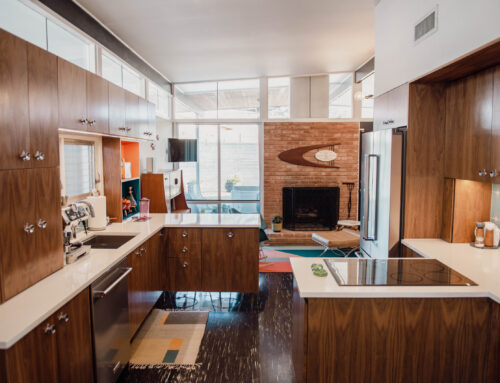Think about your typical morning routine: Your alarm clock wakes you, you grab a cup of coffee or a slice of toast, maybe flip on the television for the day’s news. Later, you’ll brush your teeth before heading to work in your car. In just that short scenario, you already would have used eight patented inventions.
Inventors have played an essential role in our nation’s advancement, and they’re still breaking new ground today. Our neighborhood is no exception – it’s filled with innovative minds, ready to bring us that next thing we just can’t live without. Over the past decade, Dallas has averaged about 735 patents per year, according the United States Patent and Trademark website. It’s safe to say that around here, there’s a steady stream of bright ideas.
But it takes more than just a “eureka” moment to be a successful inventor. “Everybody thinks: ‘I’ve got a great idea. I can bring it to market tomorrow.’ But it just takes longer than expected,” says Dick Nash, a Lake Highlands inventor.
The U.S. Patent and Trademark Office says all inventors can expect to pay at least $4,000 to get their parents granted, and on average, most end up paying more in the neighborhood of $5,000 to $10,000. And getting that patent doesn’t just take money; it also takes time – about 22 months to be exact.
After all that, inventors still aren’t guaranteed their product will ever see the light of day. Only 2 to 3 percent of inventions actually make it to the marketplace, according to Entrepreneur magazine.
But that didn’t stop the inventors we talked to. These neighbors have original ideas they believe could be the next big thing.
We’ll let you be the judge.
THE INVENTOR: Erick Flatt
THE LIGHTBULB: When Erick Flatt competed in adventure races – triathlons with mountain biking, running and kayaking – he kept running into a problem: The sweatbands he wore couldn’t match his athletic intensity. “I would saturate anything I was wearing in a very short amount of time and couldn’t keep burning sweat out of my eyes,” says Flatt. “I tried a lot of different products on the market, and none of them worked.” So he came up with his own contraption – a sweatband made of PVC that captures sweat in a lip just above the eyebrows, diverting it away from the eyes and down the temples.
THE JOURNEY: After receiving the patent in 2002, Flatt began testing his sweatband with everyone from marathon trainers to basketball and volleyball players. The clear, non-absorbent band was getting positive feedback, and around the same time Flatt’s business consulting job with accounting firm Arthur Andersen was eliminated, so he decided to devote all of his attention to his invention. By 2004 he had convinced Texas athletic stores Luke’s Locker and RunTex to carry it. “Sales were actually pretty good for a brand new product with very little marketing,” he says. Last year he brought on a business partner to focus on sales and distribution, and the Sweat GUTR is now sold in more than 300 dealer locations, both in the United States and internationally. “South Korea is our No. 1 customer right now,” Flatt says.
THE FUTURE: Right now Flatt is focused on getting his product into the nation’s top 100 bike shops. “It’s really becoming the new standard for sweatbands in that market,” he says. Flatt also has his eye on professional sport markets as well as industrial and military clients, which he thinks will be the two biggest markets next year. He also plans to integrate the sweatband into hats, visors and helmets.
THE INVENTOR: Kent Fulks
THE LIGHTBULB: While on a family vacation to Disney World, Kent Fulks talked his wife into making the hour-long drive to Lake Helena to visit the home of Arthur Jones, the man who invented the Nautilus weight machine. “I was kind of fascinated with what he brought because everything up to that point was either free weights or universal, and he had a lot of mechanics.” Fulks, who recently retired from 24 years of coaching Berkner High School football, began contemplating ways he could improve on Jones’s designs, and initially came up with a machine computer programmed with electro-magnetic resistance. He ultimately abandoned the idea because of its high cost and limited market, but a California-based company called Pacific Fitness contacted Fulks and asked to license the machine for home use. “That was the beginning,” Fulks says of his first venture in 1984. He went on to license another machine to Pacific Fitness – a bench press that allow users to pull the bar down as well as push it up. “There was no system at the time that gave you that universal ability,” Fulks says. “Men’s Journal reviewed it and said it was an amazing machine.” He created and licensed one more machine, but says he plans to retain the rights to his newest venture – the Gluteator.
THE JOURNEY: “I think it can be a specialty machine,” says Fulks of his most recent invention, which strengthens and tones the gluteus maximus as the user rotates his legs up and out from a seated position. Fulks jokes that his wife and others have confirmed that the gluteus maximus is an important muscle from a “cosmetic standpoint,” and he says it’s also an essential component in the skeletal system because it stabilizes the back. Fitness buffs are now testing the Gluteator in gyms like Preston Center’s Biomechanics. “The only way that I felt like I could get this on the market was to let mom and pop operations like this, personalized gyms, to receive it first,” Fulks says. “My biggest problem is for people to take a look and just try it out.”
THE FUTURE: Fulks has high hopes for getting the Gluteator into fitness centers across the country, and says his eventual goal is for the machine to be endorsed by the medical community for hip rehabilitation. But as for any other machines coming down the pipeline? “I don’t know if I have antoher one in me,” Fulks says.
THE INVENTORS: Dick & Sharon Nash
THE LIGHTBULB: When a coworker’s washing machine hose sprung a leak, Sharon Nash listened to her tell the exasperating story of waking up to find three inches of water in her house. “They had to move out, lost mementos, everything,” Nash says. “It took weeks and weeks and weeks for them to be able to get back in their house. The sheetrock was actually soaked, so it was almost like rebuilding a house.” Recounting the story to her husband, Dick, later that day, Sharon Nash pointed out that anyone can go to the store and buy a smoke alarm, but no one could just go out and buy a water alarm. “So she did something very daring,” says Dick Nash. “She turned to me and said, ‘Why don’t you build one?’”
THE JOURNEY: Dick Nash’s background is sales and marketing; he’s currently an insurance agent for Aflac and jokes that he “works for a duck in order to pay for a frog.” In 2002, he recruited the help of a friend to build 100 water alarm prototypes, then started talking them up as “cheap insurance” and giving them away. The Nashes intended the water alarms to be placed under sinks, toilets, washing machines and anything else that might leak, and designed them in the “cute” shape of a frog, says Dick Nash, adding: “Well, who makes the decisions about what comes into the home? It ain’t the guy.” The patent was awarded in 2003, but it wasn’t until earlier this year that the alarm took off. It was the featured product on woot.com, a Carrollton-based website that features only one item a day until it is sold out. “It went up on Friday, Feb. 17, at 6:15 a.m., and we managed to sell 2,000 frogs in 73 minutes,” Dick Nash says. “The good news was we got money; the bad news was we were out of inventory.” He ordered a few thousand more from his manufacturers in China, and sold the second batch on woot.com in 38 minutes – one per second.
THE FUTURE: The Nashes managed to sell roughly 8,000 LeakFrogs this year, and ordered another 10,000 that should arrive before Christmas. Nash has been marketing the alarm to Ace Hardware executives, and if they like it, he says, they’re going to stock it in 20 local stores. He also has his sights set on Bed, Bath & Beyond where, because of its small, cute shape, Dick Nash is hoping it will become “the impulse buy at the cash register.”
THE INVENTORS: Alicia Harris & Debbie Alspaw
THE LIGHTBULB: “The idea came to me as I was putting my kids to bed,” says Alspaw, an artist who now owns the Artzy Smartzy art studio in Lake Highlands. “I was wanting something the kids could read about themselves that had pictures of them.” The result was “All About Me,” a photo album telling the page-by-page story of a child growing up. Each page is decorated with Alspaw’s watercolor creations and contains a 3.5-by-5-inch spot to affix a photo.
THE JOURNEY: At first, Alspaw hand-painted each book and sold them at stores that were stocking her greeting cards. The response was good, so she decided to team up with her friend, Lakewood resident and freelance writer Alicia Harris, to create a second book called “All God’s Creatures.” The pair applied for a patent on the photo albums and received it in 1997, right as the scrapbooking craze was beginning. Alspaw and Harris started promoting the books at home craft shows, then selling them at small children’s stores and boutiques in Dallas and throughout Texas. They even traveled to a booksellers convention in Chicago to promote their product to retailers across the nation. The women made some headway, but they were struggling to find the right person to market the product. “It was not making money, and I think our enthusiasm waned and we realized what we were up against,” Harris says.
THE FUTURE: They’ve sold more than 1,000 books, and Alspaw still stocks them in her studio, but the pair is letting the patent expire and focusing on other projects for now – Alspaw on her art classes, and Harris on her screenwriting. “I really believe that if we somehow would’ve gone down the right path…,” Harris reflects. “You have to try stuff. I know people who are inventors who have tried and failed and tried and failed, and you just have to keep at it.” If they never attempt another patent, it won’t be for a lack of fresh ideas. What they need next time, the women say, is good marketing and financial backing. “We know we had a good idea because of the response that we had,” Alspaw says. “I would not trade the experience for anything, and it’s something that, if we had the money, we would do it again.”





